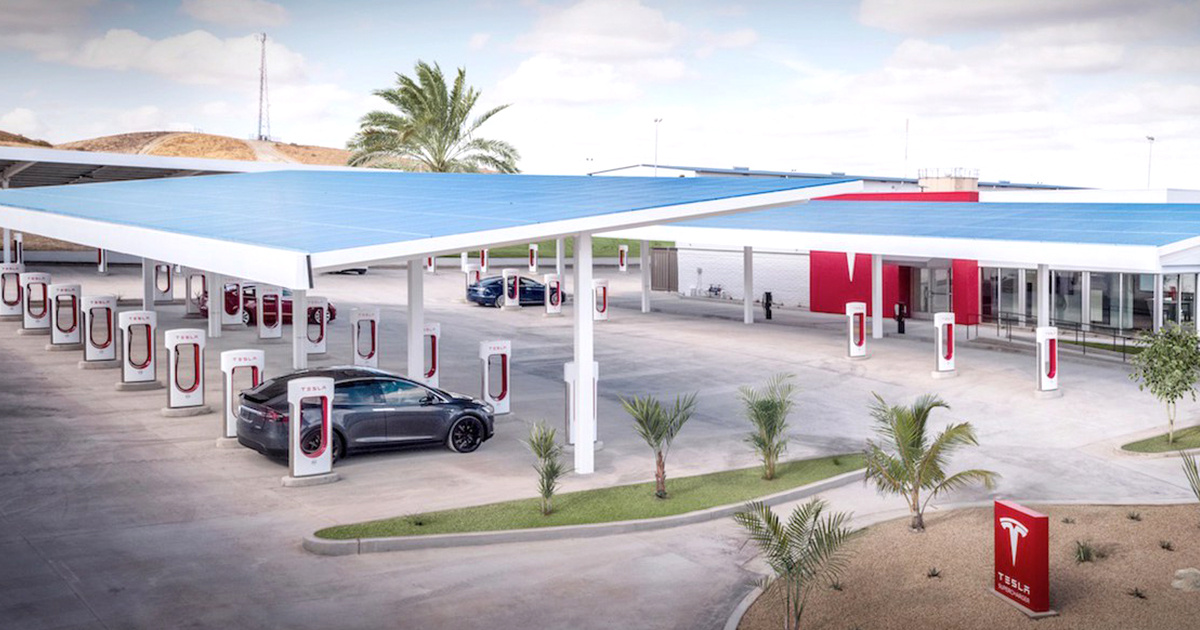
Tesla Opens Largest U.S. Supercharger Stations to Date and That’s a Big Deal

Range anxiety—the fear that an electric vehicle has an insufficient charge to reach its destination—is one of the most common, but fair, concerns about EVs. Just think, what if you and your car get stuck in the middle of a desert and have nowhere close by to juice up? Ultimately, if we want to spread the adoption of zero-emission vehicles, then we’re going to have to make them easier to charge.
That’s why
Tesla’s latest additions to its
Supercharger network is kind of a big deal. On Wednesday, the electric automaker revealed it has opened its largest Supercharger stations in the U.S. to date, according to a news release provided to EcoWatch. The 40-stall stations in Kettleman City, Calif. and Baker, Calif. each feature covered solar parking and the Tesla Powerpack System.
The new stations sit on two of Tesla’s most popular travel routes, between the Bay Area and Los Angeles and Los Angeles to Las Vegas, respectively. This means traveling around with an electric car (or at least around California in a Tesla) just got a little easier.
“Our commitment to fast, reliable, ubiquitous charging along travel routes and urban areas alike remains our priority,” the press release stated. “As we significantly increase the size of Tesla’s charging networks, more sites will include solar and Powerpack storage to ensure sustainable energy generation, storage, and charging.”
At the Kettleman City location, Tesla even built its first-ever Supercharger customer lounge that includes access to food and craft beverages, restrooms, comfortable seating, WiFi and Tesla apparel. It also has a kid’s play wall, pet relief area and outdoor space for families.
Tesla drivers typically spend about 30 minutes to Supercharge their cars, which isn’t necessarily long but it’s definitely more time-consuming than, say, filling up your car at a gas station.
Tesla CEO
Elon Musk spoke about how his company would be introducing amenities-stocked Supercharger stations in August.
“We’ll get a sense for just sort of how cool it can be to have a great place to—if you’ve been driving for three, four hours—stop, have great restrooms, great food, amenities, hang out and for half an hour and then be on your way,” he said then.
One Tesla driver has already
posted positive reviews about a visit to the Kettleman City station.
[facebook https://www.facebook.com/MojaTeslaX/posts/416043245464573 expand=1]
The new Supercharger stations are located on 27675 Bernard Dr. Kettleman City, CA 93239 and 71808 Baker Blvd Baker, CA 92309. The lounge is available 24/7 to Tesla drivers who access the building via a code available on their car’s touchscreen.
Musk’s Master Plan to help save the environment involves ditching fossil fuels and changing the way that energy is generated, stored and consumed.
Tesla introduced the Model 3 to help bring mass market interest to the nascent EV industry. Although reports have suggested that the company is mired in “production hell,” Tesla is also set to reveal its long-anticipated electric semi truck to appeal to a completely different set of drivers.
Many other major car brands have hopped onto the electric bandwagon to compete in Tesla’s space.
Volvo Cars announced in July that every car it launches from 2019 will have an electric motor, marking a “historic end” to the internal combustion engine.
Then in September, Volkswagen Group, the world’s biggest automaker, announced plans to offer an electric version across the company’s 300 models by 2030, and to roll out 80 new electric cars under its multiple brands by 2025. The German company, which is trying to rebound after its emissions-cheating scandal, is investing more than 20 billion euros ($24 billion) in zero-emission vehicles to challenge Tesla.
Electric vehicle sales are poised to surge worldwide as an increasing number of countries such as China, Scotland, France and India announced intentions to ban diesel and gasoline cars in order to cut emissions.

 233k
233k  41k
41k  Subscribe
Subscribe 